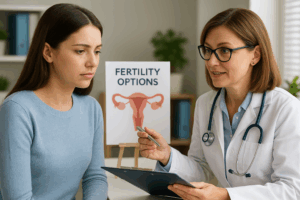Living with Congenital Adrenal Hyperplasia (CAH) has been one of the most defining parts of my life—not just a diagnosis but a daily journey in understanding and managing my hormones, body, and emotions. If you’re here, you’re probably wondering what it’s really like to live with CAH or supporting someone who does. I hope my story helps shed light on the reality behind the medical jargon and brings you closer to the human side of managing CAH.

What Is CAH and How It Shapes Life?
CAH is a genetic condition that disrupts how my adrenal glands produce hormones—specifically, cortisol and aldosterone. Because of a missing or deficient enzyme (usually 21-hydroxylase), my body ends up producing too much androgen (a “male” hormone). This imbalance started affecting me even before birth and has followed me through every life stage—from puberty to adulthood.
There are two types of CAH: classic CAH and nonclassic CAH. I was diagnosed with nonclassic CAH in my late teens after years of symptoms that didn’t make sense. Like many others, my symptoms mimicked PCOS, so it took hormonal tests and a CAH gene panel to finally pinpoint the real cause.
My Puberty Story: More Than Just Growing Pains
Puberty with CAH was a roller coaster. I was taller than my classmates at 10, then stopped growing. My voice deepened a bit, I struggled with severe acne, and my periods were irregular. Managing body hair was exhausting—and honestly, it hurt my confidence.
Many girls with CAH go through early growth spurts and face challenges like hirsutism, acne, or irregular periods. It’s not just about appearance—it affects how you feel about yourself. In support groups, I’ve met many women who, like me, felt isolated or confused during those years. Some also had early genital surgeries, which added another layer of emotional complexity around identity and intimacy later in life.
Exercise, Hormones, and Finding Balance
Managing CAH through exercise has been life-changing for me. Strength training and regular cardio help balance my weight, mood, and androgen levels. However, I had to learn (sometimes the hard way) that overtraining can stress the adrenal glands.
Now, I follow a personalized plan guided by my endocrinologist, balancing workouts with adequate rest and consistent hormone management. If you’re thinking about incorporating exercise with CAH, start slow, listen to your body, and work with your medical team.
Fertility, Pregnancy, and Hope
One of the hardest parts of my journey was discovering how CAH affects fertility. In my twenties, I learned that high androgen levels were disrupting ovulation. It was overwhelming, but knowing I wasn’t alone made a huge difference.
Thanks to the right hormonal treatment, I now have a regular cycle. Many women with CAH can and do become mothers—sometimes naturally, sometimes with help like IVF. When I began thinking about pregnancy, my medical team adjusted my medications carefully. It takes teamwork between endocrinologists, OB/GYNs, and mental health support because the emotional side of fertility struggles is just as important.
Emotional Wellness: More Than Hormones
Living with CAH isn’t just a physical challenge—it’s deeply emotional. For a long time, I carried feelings of shame and “otherness.” Building my identity beyond CAH has taken time, therapy, and community. Connecting with other women who share their personal stories of CAH has been the most healing experience.
Learning that I’m not defined by my diagnosis—and that I can embrace life fully—has changed everything. If you’re reading this and struggling, please know: therapy and peer support can help more than you might imagine.
Diagnosis and Treatment: What I’ve Learned
For many women, nonclassic CAH is missed for years. I encourage anyone with symptoms like irregular cycles, excess hair, or persistent acne to push for hormonal testing—including 17-hydroxyprogesterone levels and an ACTH stimulation test. A CAH gene panel can also confirm the diagnosis.
Treatment is usually with glucocorticoids, sometimes mineralocorticoids if you have the classic type. It’s all about balance—too little treatment leaves you symptomatic, too much brings side effects like mood swings or weight gain. Regular follow-ups and open communication with your endocrinologist are key.
Living Well with CAH: My Advice
Managing CAH is not about chasing perfection—it’s about understanding your body, working with it, and building the life you want. Today, I live fully: I have a career I love, supportive relationships, and plans for the future. Like many women with CAH, I’ve learned that this condition is just one part of me—not my whole story.
For anyone starting their journey or supporting a loved one, here’s what I’ve learned:
-
Seek out CAH-experienced medical teams
-
Embrace therapy or support groups
-
Stay informed and proactive
-
Celebrate progress—every step counts
Conclusion
Congenital Adrenal Hyperplasia (CAH) is a complex condition that touches every part of life: body, mind, and heart. Managing CAH means more than just taking meds—it’s about building confidence, finding community, and living life on your terms.
Through hormone management, personalized exercise, and emotional healing, I’ve made peace with my body and my hormones. And if you’re navigating this path too—know that you can thrive, not in spite of CAH, but alongside it.
